Tempering chocolate can be an intimidating process at first, but once you do, a whole new area of the pastry field will open for you. The method described below is easy and can be used for any application which requires tempered chocolate.
If you are making chocolate mousse, brownies, ganache and many other products where chocolate is mixed into the mixture, generally it is not necessary to temper the chocolate. However when making molded chocolate, chocolate decorations, dipping chocolates, truffles or cookies or other items which require the chocolate to harden to a beautiful sheen, there is no other way but to temper chocolate.
Simply melting chocolate without tempering and then using it for final coating and molding will result in a very disappointing end product. It will take a very long time before untempered chocolate hardens and when it does, it will have a grayish coating and the chocolate will be crumbly.

Chocolate contains cocoa butter and when melted the cocoa butter crystals become unstable. The tempering process ensures the formation of stable cocoa butter crystals. Perfectly tempered chocolate and stable cocoa butter crystals will give us chocolate which hardens with a perfect sheen and a crisp snap.
Many methods of tempering are used and pastry chefs and chocolatiers may use a variety of them based upon their needs. When I need a small amount of tempered chocolate at work or at home I particularly like to use the ice bath method which I explain below.

Before we get started on tempering chocolate we have to take a closer look at what is available to the consumer at home and to the professional. The professional pastry chef is able to purchase chocolate which is labeled Chocolate Couverture. (koo-vehr-TYOOR) The labeling of Couverture basically signals to the user that this type of chocolate contains a minimum of 32 % cocoa butter. Chocolate containing less than 32 % cocoa butter will not melt to a proper workable fluid state. When melted it will be thick and be completely unusable for most dipping and other types of uses.
Do not confuse the % number you may see listed on chocolate bars, such as 60% or 70% cocoa with the cocoa butter content! This number reflects mainly the cocoa mass content-the strength of chocolate flavor and partly cocoa butter.
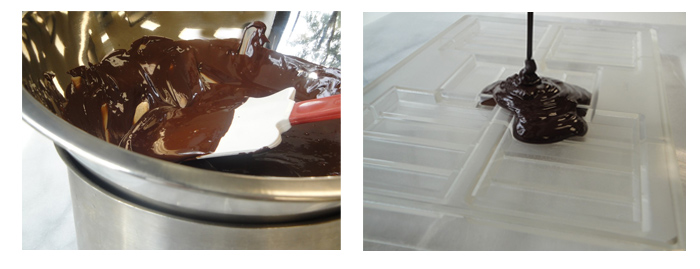
At the grocery store finding chocolate labeled couverture is not always easy. In fact, most chocolate sold in grocery stores contains a whole lot less cocoa butter. Now you may think great, less fat means better for me! Perhaps, but when we want to really work with chocolate, not just make brownies, but dipping and molding we do need MORE cocoa butter! We basically need couverture chocolate, the stuff which contains at least 32 % cocoa butter.
When you are looking at chocolate in the store and it is not labeled couverture, believe the manufacturer. If it was, it more than likely would be labeled as such. After all, cocoa butter is the most expensive ingredient in chocolate. If you cannot find couverture chocolate in the store, an option is to add pure cocoa butter to non couverture type chocolate. This way you bring the cocoa butter level up couverture standards and it will melt properly. Adding cocoa butter to chocolate will also make it taste better and smoother.
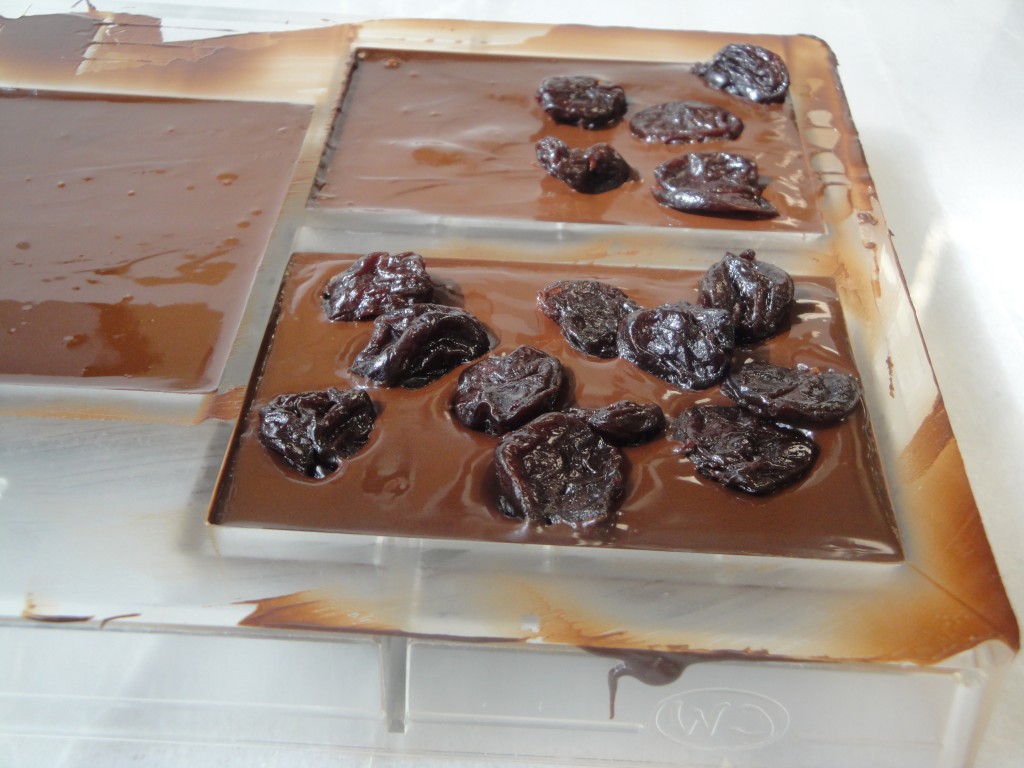
Callebaut, a very good quality Belgian chocolate can be found worldwide. In the United States, Callebaut chocolate is available in places such as Whole Foods Market. At this market, they also stock food grade cocoa butter (In the cosmetics department). So if you want to make truffles, chocolates, dip strawberries in chocolate and have a professional looking result, you know where to get the stuff! Here is what you do:
Make sure you have a thermometer. I like a simple digital one; they are not expensive and work fantastic. Select the chocolate that you prefer such as semi sweet or bittersweet. Remember the higher the % number listed on the label the stronger the cocoa flavor and less sweet it will be. If you have a scale, great! Weigh the chocolate and add 10% of cocoa butter to the chocolate. For example if you have 1 lb 2 oz (500 gram) of chocolate, add 10% cocoa butter = 1 ¾ oz (50 gram). It is ok to go up about 15% with the cocoa butter. Higher than that will make your chocolate VERY fluid. If you do not have a scale, chop the chocolate and measure in a cup. Look at the metric side of your measuring cup and note the amount, let’s assume it measures 600 gram. Then chop the cocoa butter and measure 60 gram (10%).
Before you begin melting the chocolate make sure that during the entire process of working with chocolate no water enters the chocolate. Water will thicken not thin the chocolate. Combine the small chopped pieces of chocolate and cocoa butter and place in a bowl. Fill a saucepan with about one inch (3 cm) water and bring to a very low simmer. Place the chocolate bowl on the saucepan (Chocolate bowl cannot touch the water!) and stir the chocolate using a rubber spatula until it reaches 115-120F(46-48C). Remove from heat and place the bowl containing the melted chocolate into a bowl filled with ice cubes, stir constantly. When the chocolate forms a firm layer on the bottom of the bowl, lift it out of the ice and stir a few seconds. Stir until the chocolate cools to 78-80F (25-26C) and then remove it from the ice. Place the bowl back over the low simmering water for a just a few seconds at a time and heat the chocolate to 86-90. (30-32C) The chocolate is now in temper! Be careful not to heat above the indicated temperatures or the chocolate will be out of temper. If you have heated above the highest allowed temperatures start the process by heating the chocolate to 115 -120F (46-48C) and continue as described.
Now you have tempered chocolate which you can use for any type of application where tempered chocolate is required. You will have this chocolate in temper as long as you keep it fluid below 90F (32C). You can set the bowl of tempered chocolate in a bowl filled with water of 90 F (32C) to keep it fluid longer. You can always re-temper chocolate. Overheated or cooled, it does not matter. You can always bring it back to temper by following the tempering process.

The pictures show the tempering process and the making of chocolate bars with sun dried cherries using chocolate with a 60% cocoa mass. Once the tempered chocolate is poured into the molds scrape off the excess with a pastry spatula. Immediately add the sun dried cherries. Place in a refrigerator for about 30 minutes before unmolding.
For milk and white chocolate the tempering temperatures are slightly different. Heat either chocolate to 115 and cool to 78 on ice. Reheat only to a maximum of 87.
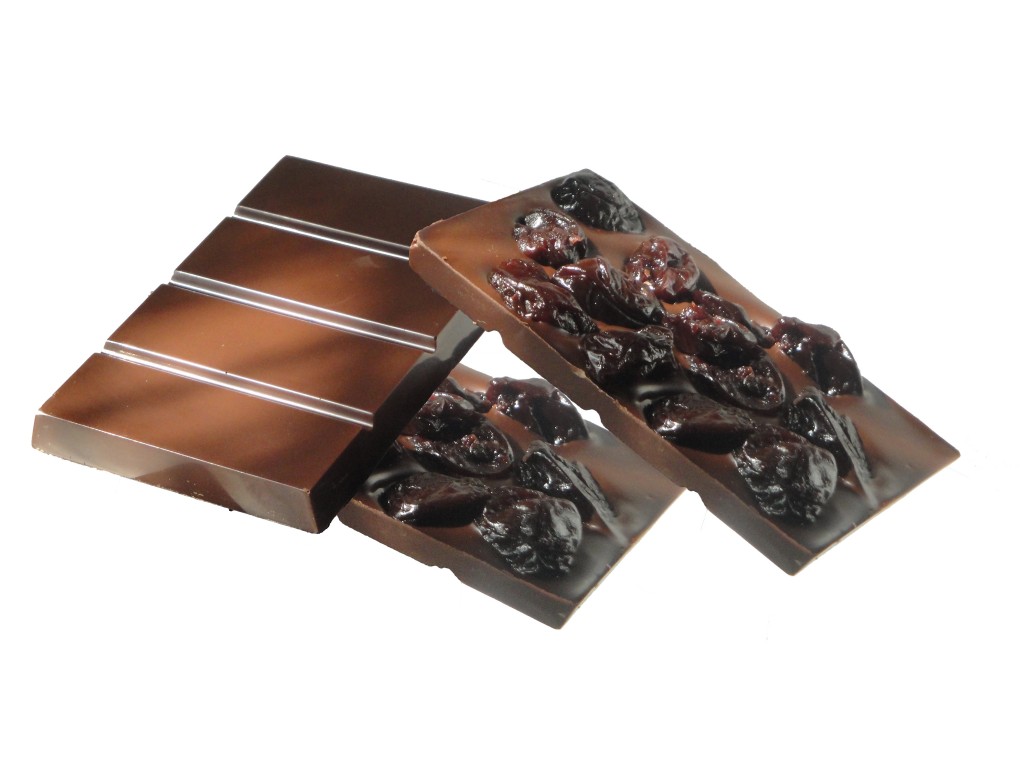
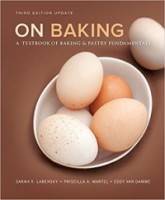
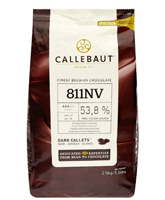

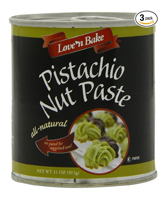
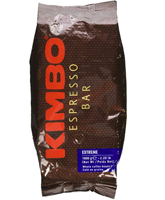
This is great information! I will pass this on!
WOW! This morning I followed this method as described and it WORKED! Nobody ever explained why my chocolate would not melt right. Thank you!
Ken.
This morning I tempered chocolate using this technique and I had 100% success. Thank you chef Eddy Van Damme.
My friends and I just tempered chocolate this way and had a fabulous time doing it. Fun, easy and delicious! Thanks!
This is the best way of tempering chocolate for small amounts. Great info!
I Love to use this method at my places of work. This method of tempering makes the final product have a great sheen. Thank you for help 🙂
Brilliant!!!! I never thought this could be soooo easy to do. Chocolate was something that always discouagre me, but now after discoving the method of tempering, Its much easier to work with chocolate! THANKS!!!!
The finish chocolate looks fantastic. I will make sure to remember this when I make chocolate covered strawberries, thanks chef.
This was great information. Since I am a novice to the chocolate making world, any sources of information is very helpful for me right now. I will keep in mind the 10% ratio for cocoa butter.
i really like the ice method for tempering the chocolate.
Thanks Chef! I can’t wait to test this out at home.
I think that the ice method that we used in class for the chocolate mousse tart was simple and easy to remember and easy to work with also its less of a hassel than the method that we first used the first day in class
Hello Chef Eddie,
I want to thank you for writing this recipe for my refreshing. You are an inspiration to me and it is an honor to be your student. I could only pray to be as gifted as my teacher and to continue to have such a great compassion as it is evident by your teaching. Pastry is a science and a world of it’s own . You sir are deserving of the title “Prince of Pastry”.
I am going to work hard to earn the title of Chef and following in the foot steps of my teacher.
Thank you,
Carol
I know that properly tempered chocolate comes out with a glossy finish. On t.v. i saw a chef make truffles with an ultra glossy finish, what did she do to achieve that?
I am using dipped strawberries on a cake this weekend and I would like to use this method. Seeing it in writing and remembering your demostration make it easler to do. Thank for a clearer understanding.
Amazing.. amazing!!! I recently made a blackberry chocolate cupcake for a baby shower, it came out beautiful and tasteful! This method of tempering chocolate enlightened me more on the best way to handle chocolate.
Thank you so much Chef Eddy ^_^v
chef i think theres typo on your blog in the following sentance you forgot to insert the temp. for when you are suposed to remove from the ice
hello chef Eddy
Hello chef Eddy , is an onor to be your student , every day is somting new to see . and you are the Artist. If picaso whas a life he will take some of your art into hes peinting inspirations .
Tank you .
Chef Hector Rey .
Hello Chef Eddie,
Just looking at the undated recipe. I enjoy learning the Art of Baking it’s a real chemistry.
I am so amazed at every class.
Thank you……….. Carol
This was a very helpful guide. I have attempted tempering chocolate in the past, but it never turned out right. I shall try again with your help!
Chef Eddy,
I have been making candy for years and was excited to come across your blog and the ice method for tempering. I have saved so much time already this holiday season using the ice tempering that I will finish ahead of schedule. THANKS. You’re terrific. And I can’t wait to try the toffee recipe.
Marc,
It is great to hear that the ice tempering method is working out fantastic for you!
All the best and sell a lot of your chocolates this season!
Eddy.
Hey Chef Eddy,
Chef richard gave us a testing of the chocolate during last Wednesday’s chocolate demostration. He did it very simple and easy. Wow, chocolates are good for any type of dessert. But it is still contains alot of cocoa mass. Both white chocolate and dark chocolate have this sweet flavor and smell. Thanks Chef…
This wonderful guide gave me the courage to finally try tempering chocolate myself. I’ve done it several times since, and it never failed.
I tend to loose temper after several reheatings though. I admit I don’t pay much attention to the temperature while I’m working with the chocolate and just reheat it whenever I feel it’s cooled too much.
Dear Chef Eddy,
Thank you for the tutorial; I would like to ask, if I can still temper chocolate in absence of cocoa butter.
Or do I need to substitute it with some other ingredient?
Thank you once again for the instructions.
Aida,
Yes you can temper chocolate without using cocoa butter. The best thing to do is simply start by using couverture chocolate which nowadays is easy to obtain in larger stores or via the net. Couverture chocolate contains enough cocoa butter to nake the tempering procces work smoothly.
Eddy.
Thanks for the demo in class chef.
I really didn’t like this method when it was shown in class; I much prefer the regular method. I think I should work on it anyway, because I know I’ll need/use it again.
What a great information! You make it so simple and easy to understand why do we need to temper our chocolate and how to do it. I will need to try Chef Eddy’s way of tempering chocolate.
Additionaly, I learn more about chocolate from your blog.
Fascinating! A merging of science with extreme artistry. Chocolate has 6 different crystals, 5 of which are unstable. The trick is to form the 1 stable crystal before creating your piece. I can’t wait to try this!
It is extremely fascinating and eye opening this whole world of chocolate.
It’s a superlative entry, Chef Eddy! You do make tempering chocolate much less intimidating.
I agree with Nikki. This method seems to be too finicky and the risk of having the chocolate seize is just too high. However, it would be beneficial to know this method just in case it is the only method available.
My only concern with the ice method when we experimented in class was the speed at which the chocolate set on the sides of the bowl when we placed it in ice. Other than that, I was impressed by how much quicker the tempering process was. Practice practice practice, right?!
Hi Chef Eddy,
i love all the different ideas of tempuring chocolate. The one i do think is the quickest, but ardest is the ice bath one. Does it matter the percentage of cocoa mass in a chclate when tempuring it, or is that just for the taste and color?
The demo you did last week with the ice method make it seem easy, but when we actually did it, it was actually a bit tricky. I think I would prefer the other way without doing the ice method.
Hello Chef Eddie;
I really wish I had read this before going into class last Tuesday, I messed up on my tempering but I think I know now what not to do. This is a great and very detailed blog thank you.
hi chef;
why did dark choc easily becoming dusty and dull, do you have any suggestion to prevent a dark chocolate praline from being dusty and dull during storage condition?
Hmmmm, is the chocolate properly tempered? Remember, when dipping chocolates in tempered chocolate, the chocolate should firm within one minute. If not, the room may be too warm or the chocolate was not tempered correctly. Poor quality chocolate contains less cocoa butter and will also contribute to a dull appearance. Your chocolate should contain a minimum of 32% cocoa butter. (Do not confuse this number with cocoa mass) Storing the chocolates too warm will do the same.
Let me know how it works out.
All the best, Eddy
Chocolate, Tarts, Cookies ,it’s all good comming from you.I have learning so much about everything,to know I can buy cocoa butter from the cosmetics department is great to know. Great information my chocolate cover strawberries can now hang with the best of them.
Chef Eddy,
Great information, by far the easiest and best way for tempering chocolate I have found.
Very clear explained and very interesting information in how to temper chocolate.
Hi Chef Eddy,
From your blog, it seems like tempering chocolate is a little complicated. But once we started tempering in class it was so simple.
I am very intrigued by the ice bath method. I did not realize that the cocoa mass and cocoa butter % were different. Honestly, before we started our classes I never really worked with chocolate other than some brownies. I am fascinated at how water will thicken the chocolate. I have done fondue in the past, and always wondered why it never worked out. I now know to make sure my equipment is dry, and the chocolate is at the correct temperature to add the cocoa butter. I also learned that if the chocolate becomes too cold, or too hot you can just temper it once again. No need to waste any chocolate. : )
Korrie Smith
From now on, I know how to properly make Lime-Coconut Macaroons dipped in chocolate! lol, Thanks!
Chef Eddy,
For those of us who tell if chocolate is tempered by testing it to see if it is firm in 60 seconds do u feel it is still important to get use to using a thermometer and knowing the temps?
Chef, thanks for explaining about couverture. I did not realize the percentage number on the bars in grocery stores only represented the mass! I wish we had a whole foods out here in Katy! Maybe one day soon. 🙂
Hi Mayah,
Even though I kinda know how fast I drive my car, I still like to check my speedometer. Same with chocolate, I know it is in temper but I still like to check with a thermometer.
My best,
Eddy
Temp chocolate is little hard but i temp chocolate with pot with water.
If I buy couverture milk chocolate, can I still add cocoa butter when I temper it? And if so, would it still be in the amount of 1%? I am trying to duplicate a rocky road candy I sampled at a party. All they would tell me is that they bought chocolate and cocoa butter at a certain store. Thanks.